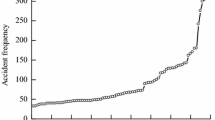Abstract
This study aims to address two potential issues regarding accident prediction models. (a) What are the benefits of using the prior information on the accuracy of prediction model, and (b) how to include the available prior knowledge of accident occurrences data in the prediction process? In accident databases, the prior knowledge can be defined as the most probable points in which an accident has happened in the earlier years and is closely correlated to its upcoming years. Large databases such as traffic and accident databases, inevitably contain noisy data. Therefore, to have accurate results, using approaches to alleviate the impact of these anomalies is significant. In this research, a hybrid method based on a module of prediction and a prior knowledge block is proposed. The module used for prediction is Recursive Least Square filter and Maximum a Posterior (MAP) estimator is used as the prior knowledge block. Results indicate an increase in accuracy of prediction by using the proposed hybrid model.
Similar content being viewed by others
References
Bandyopadhyaya, R. and Mitra, S. (2011). Comparative Analysis of Hotspot Identification Methods in the Pres-ence of Limited Information, 3rd International Conference on Road Safety and Simulation Transportation Research Board, Indianapolis, USA.
Chandore, P. and Chatur, P. (2013). “Outlier detection techniques over streaming data in data mining: A research perspective.” International Journal of Advanced Research in Computer Science and Software Engineering, pp. 12–16.
Chen, S., Wang, W., and Van Zuylen, H. (2010). “A comparison of outlier detection algorithms for ITS data.” Expert Systems with Applications, Vol. 37, No. 00, pp. 1169–1178, DOI: 10.1016/j.eswa.2009.06.008.
Department for Transport, G. B. E., Scotland, Wales, 2014. 2014 Road Safety -Accidents 2014.
El-basyouny, K. and Sayed, T. (2009). “Urban arterial accident prediction models with spatial effects.” Transportation Research Record: Journal of the Transportation Research Board, pp. 27–33, DOI: 10.3141/2102-04.
Guo, J., Huang, W., and Williams, B. M. (2015). “Real time traffic flow outlier detection using short-term traffic conditional variance prediction.” Transportation Research Part C: Emerging Technologies, Vol. 50, No. 00, pp. 160–172, DOI: 10.1016/j.trc.2014.07.005.
Hodge, V. J. and Austin, J. (2004). “A survey of outlier detection methodologies.” Artificial Intelligence Review, Vol. 22, No. 00, pp. 85–126, DOI: 10.1023/B:AIRE.0000045502.10941.a9.
Lee, C., Hellinga, B., and Saccomanno, F. (2003). “Real-time crash prediction model for application to crash prevention in freeway traffic.” Transportation Research Record: Journal of the Transportation Research Board, pp. 67–77, DOI: 10.3141/1840-08.
Lin, F., Sayed, T., and Deleur, P. (2003). “Estimating safety benefits of road improvements: Case based approach.” Journal of transportation engineering, Vol. 129, No. 00, pp. 385–391, DOI: 10.1061/(ASCE) 0733-47X(2003)129:4(385).
Ljung, L. (1987). “System identification: theory for the user.” Englewood Cliffs.
Miranda-moreno, L. F. (2006). Statistical models and methods for identifying hazardous locations for safety improvements, DOI: 10.1016/j.aap.2007.03.008.
Miranda-moreno, L. F., Heydari, S., Lord, D., and Fu, L. (2013). “Bayesian road safety analysis: Incorporation of past evidence and effect of hyper-prior choice.” Journal of safety research, Vol. 46, No. 00, pp. 31–40, DOI: 10.1016/j.jsr.2013.03.003.
O’day, J. (1993). Accident data quality, Transportation Research Board.
Schlüter, P., Deely, J., and Nicholson, A. (1997). “Ranking and selecting motor vehicle accident sites by using a hierarchical Bayesian model.” Journal of the Royal Statistical Society: Series D (The Statistician), 46, 293–316, DOI: 10.1111/1467-9884.00084.
Vaseghi, S. V. (2008). Advanced digital signal processing and noise reduction, John Wiley & Sons.
Xie, Y., Zhang, Y., and Liang, F. (2009). “Crash injury severity analysis using Bayesian ordered probit models.” Journal of Transportation Engineering, Vol. 135, No. 00, pp. 18–25, DOI: 10.1061/(ASCE) 0733-947X(2009)135:1(18).
Author information
Authors and Affiliations
Corresponding author
Rights and permissions
About this article
Cite this article
Mansourkhaki, A., Karimpour, A. & Yazdi, H.S. Introducing prior knowledge for a hybrid accident prediction model. KSCE J Civ Eng 21, 1912–1918 (2017). https://doi.org/10.1007/s12205-016-0495-4
Received:
Revised:
Accepted:
Published:
Issue Date:
DOI: https://doi.org/10.1007/s12205-016-0495-4




